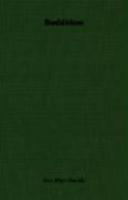
Book Summary
BUDDHISMBY MRS. RHYS DAVIDS, M.A. CONTENTS: I THE PALI TRADITION II DHAMMA AND ABHIDHAMMA III THE NOBM AS THEORY OF No-SouL IV THB NOBM AS THE LAW OF CAUSATIDK V THB NOBM AS MOBAL LAW VI THB NOBM AS IDEAL. VII THB NOBM AS IDEAL (continued) VIII THB QUEST OF THE IDEAL IX THB IMPORT OF DHAMMA CONCLUSION. CHRONOLOGICAL NOTE BIBLIOGRAPHY. INDEX...... . 255 BUDDHISM CHAPTER I THE PALI TRADITION THE general growth of interest in Buddhism is due to more than one assignable cause. But we may class the various causes fairly enough under the growth of general knowledge. And under this fact of expanding knowledge we may distinguish between growth of intellectual curiosity and sympathy in the knower, and additional facilities in the means of knowing. We must resist the temptation, in the limited scope at our disposal, of lingering over the former group of causes, and glance forthwith at the latter. In the first place we are now beginning to reap the harvest sown by certain pioneers, who returned last century from countries where creed and culture are or have been Buddhist, in their hearts the wish, on their shoulders the task, to make known in the West a literature venerable in its tradition, and, where still followed, a living force in the present, but practically unknown outside Asia. This was the religious literature of Ceylon, Siam, and Burma, written on palmleaf manuscripts, and, for the most part, in a language not at any time native to any of those countries, but hailing from the ancient dialects of North-East India. Closely akin to this language, which, as a literary diction, is known in the mediaeval portion of the literature as pdli (or The Text), is that of certain inscriptions carved onrock and pillar, found in different parts of India. These are known as the Edicts of the Emperor Asoka, the Indian over-lord who reigned about 272-35 B.C. They consist largely of injunctions to righteous and fraternal conduct, and refer to passages contained in the most ancient of these same Pali compositions. These oldest compilations are treasured, in the three countries above-named, as canonical scriptures. And the Pali language is judged to be a literary version of an Indo-European or Aryan dialect, later than the language of the Vedas and Brahmanas, or oldest known Brahmin texts, but earlier than what is called Sanskrit, that is, the literary language of India during nearly the whole of the Christian era. Now this Pali was the vehicle of what is, so far as we have yet been able to discover, the earliest formulated records of Buddhism. Dead as a vernacular, it still lives on as a literary instrument in the native colleges or monasteries of Ceylon, Siam, and Burma, just as Latin was the mediaeval, and is, to some extent still, the modern v ecclesiastical Christianity. In its v or spoken form, it appears to have been the alanguage, according to Buddhist commenrtarial tradition, of Mag'adha, according to Rhys Davids, of Kosala, about the fifth century B.C. (or earlier) and subsequent centuries.
Book Details
| Book Name | Buddhism |
| Author | Mrs Rhys Davids |
| Publisher | Hesperides Press (May 2006) |
| ISBN | 9781406713169 |
| Pages | 264 |
| Language | English |
| Price | 1373 |








